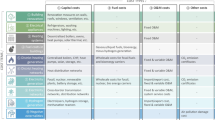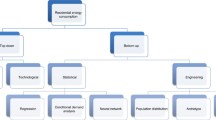Abstract
Understanding the potential for reducing energy demand through increased end-use energy efficiency can inform energy and climate policy decisions. However, if potential estimates are vastly different, they engender controversial debates, clouding the usefulness of energy efficiency in shaping a clean energy future. A substantive question thus arises: is there a general consensus on the potential estimates? To answer this question, this paper reviews recent studies of US national and regional energy efficiency potential in buildings and industry. Although these studies are based on differing assumptions, methods, and data, they suggest technically possible reductions of ~25–40 % in electricity demand and ~30 % in natural gas demand in 2020 and economic reductions of ~10–25 % in electricity demand and ~20 % in natural gas demand in 2020. These estimates imply that electricity growth from 2009 to 2020 ranges from turning US electricity demand growth negative, to reducing it to a growth rate of ~0.3 %/year (compared to ~1 % baseline growth).




Similar content being viewed by others
Notes
See Fig. ES-13 for the regional breakdown of the EPRI RAP for 2020 (EPRI 2009).
For the purposes of this paper, capital investments include equipment, installation, and operational costs for energy efficiency; program administration costs are a separate cost to the capital investments. Depending on the level of the incentive, total program costs may include capital investments in addition to program administration costs.
References
American Council for an Energy-Efficient Economy (2010). State Energy Efficiency resource standard (EERS) activity. Washington, DC: American Council for an Energy-Efficient Economy.
Arimura, T., Shanjun, L., Newell, R. G., & Palmer, K. (2012). Cost effectiveness of electricity energy efficiency programs. The Energy Journal, 33(2), 63–98.
Auffhammer, M., Blumstein, C., & Fowlie, M. (2008). Demand side management and energy efficiency revisited. The Energy Journal, 29(3), 91–104.
Brown, M. A. (2001). Market failures and barriers as a basis for clean energy policies. Energy Policy, 29(14), 1197–1207.
Brown, M. A. Chandler, S.(J.) (2008). Governing confusion: how statutes, fiscal policy, and regulations impede clean energy technologies. Stanford Law and Policy Review, 19(3), 472–509.
Brown, M. A., Gumerman, E., Sun, X., Baek, Y., Wang, J., Cortes, R., & Soumonni, D. (2010). Energy efficiency in the south. Atlanta: Southeast Energy Efficiency Alliance.
Chandler, J. (2010). A preliminary look at electric efficiency potential. The Electricity Journal, 23(1), 85–91.
Chandler, S.(J.), Brown, M. (2009). Meta-review of efficiency potential studies and their implications for the south. Working Paper #51, Georgia Institute of Technology.
Electric Power Research Institute (2009). Assessment of achievable potential from energy efficiency and demand response programs in the U.S. (2010–2030). Report 1016987. Palo Alto: Electric Power Research Institute.
Energy Center of Wisconsin and American Council for an Energy Efficient Economy (2009). A review and analysis of existing studies of the energy efficiency resource potential in the Midwest. A policy white paper in support of the Midwestern Governors Association Energy and Climate Change Platform; Energy Center of Wisconsin, ECW Report Number 247-1.
Eyre, N. (1998). A golden age or a false dawn? Energy efficiency in UK competitive energy markets. Energy Policy, 26(12), 963–972.
Fisher, A. C., & Rothkopf, M. H. (1989). Market failure and energy policy. A rationale for selective conservation. Energy Policy, 17(4), 397–406.
Frisch, C. (2008). Electric utility demand side management: Defining and evaluating achievable potential. Master’s project, Duke University.
Gellings, C. W., Wikler, G., & Ghosh, D. (2006). Assessment of U.S. electric end-use energy efficiency potential. The Electricity Journal, 19(9), 55–69.
Gillingham, K., Newell, R. G., & Palmer, K. (2006). Retrospective review of energy efficiency policies. Annual Review of Environment and Resources, 31, 10.1–10.31.
Gillingham, K., Newell, R. G., & Palmer, K. (2009). Energy efficiency economics and policy. Annual Review of Resource Economics, 1, 14.1–14.23.
Greening, L., Greene, D. L., & Difiglio, C. (2000). Energy efficiency and consumption—The rebound effect—A survey. Energy Policy, 28(6 7), 389–401.
Hassett, K., & Metcalf, G. E. (1993). Energy conservation investment. Do consumers discount the future correctly? Energy Policy, 21(6), 710–716.
Hirst, E., & Brown, M. (1990). Closing the efficiency gap: barriers to the efficient use of energy. Resources, Conservation and Recycling, 3(4), 267–281.
Interlaboratory Working Group (2000). Scenarios for a clean energy future. Report ORNL/CON 476 and LBNL 44029. Oak Ridge, Tennessee, and Berkeley: Oak Ridge National Laboratory and Lawrence Berkeley National Laboratory.
Jaffe, A. B., & Stavins, R. N. (1994). The energy efficiency gap. What does it mean? Energy Policy, 22(10), 804–810.
Jaffe, A. B., Newell, R. G., & Stavins, R. N. (2004). Economics of energy efficiency. Encyclopedia of Energy, 2, 79–90.
Lutzenhiser, L. (1994). Innovation and organizational networks. Barriers to energy efficiency in the US housing industry. Energy Policy, 22(10), 867–876.
McKinsey and Co. (2007). Reducing U.S. greenhouse gas emissions: How much at what cost. New York: McKinsey and Co.
McKinsey and Co. (2009a). Unlocking energy efficiency in the U.S. economy. New York: McKinsey and Co.
McKinsey and Co. (2009b). EPRI and McKinsey reports on energy efficiency: A comparison. New York: McKinsey and Co.
Metcalf, G. E. (1994). Economics and rational conservation policy. Energy Policy, 22(10), 819–825.
National Academies. (2010). Real prospects for energy efficiency in the United States. Washington, DC: National Academies.
National Action Plan for Energy Efficiency (2007). Guide for conducting energy efficiency potential studies. Prepared by Philip Mosenthal and Jeffrey Loiter, Optimal Energy, Inc.
National Action Plan for Energy Efficiency (2008). Understanding cost-effectiveness of energy efficiency programs: Best practices, technical methods, and emerging issues for policy-makers. Prepared by Energy and Environmental Economics, Inc. and Regulatory Assistance Project.
National Action Plan for Energy Efficiency (2006). A plan developed by more than 50 leading organizations in pursuit of energy savings and environmental benefits through electric and natural gas energy efficiency, chapter 5, rate design. Prepared by Energy and Environmental Economics.
Rufo, M., Coito, F. (2002). California’s secret energy surplus: The potential for energy efficiency. California: The Energy Foundation and The Hewlett Foundation.
Sanstad, A. H., & Howarth, R. B. (1994). Normal markets, market imperfections and energy efficiency. Energy Policy, 22(10), 811–818.
Sanstad, A. H., Blumstein, C., & Stoft, S. E. (1995). How high are option values in energy efficiency investments? Energy Policy, 23(9), 739–743.
Sorrell, S., Dimitropoulos, J., & Sommerville, M. (2009). Empirical estimates of the direct rebound effect: A review. Energy Policy, 37(4), 1356–1371.
United States Environmental Protection Agency (2009). EPA preliminary analysis of the American Clean Energy and Security Act of 2009 in the 111th Congress. GHG emissions reductions were drawn from IGEM model results.
Acknowledgments
This work was supported in part by a fellowship administered by the American Association for the Advancement of Science (AAAS), in cooperation with the US Environmental Protection Agency (under Cooperative Agreement No. X3 83232801). The author especially thanks Alan Sanstad of the Lawrence Berkeley National Laboratory, Joe Bryson and Jeff Brown of the US Environmental Protection Agency, and C.K. Woo of Energy and Environmental Economics for their helpful suggestions. The following individuals are thanked for providing clarification on their respectively authored studies: Omar Siddiqui of the Electric Power Research Institute; Greg Wickler of Global Energy Partners; Jon Creyts, Phil Farese, Anton Derkach, and Doug Weiss of McKinsey and Co.; and John Cymbalsky and John Conti of the Energy Information Administration. I thank Omar Siddiqui for providing information from their report in electronic form and Jon Creyts for providing unpublished data and the permission to use them in this paper.
Author information
Authors and Affiliations
Corresponding author
Rights and permissions
About this article
Cite this article
Sreedharan, P. Recent estimates of energy efficiency potential in the USA. Energy Efficiency 6, 433–445 (2013). https://doi.org/10.1007/s12053-012-9183-5
Received:
Accepted:
Published:
Issue Date:
DOI: https://doi.org/10.1007/s12053-012-9183-5




